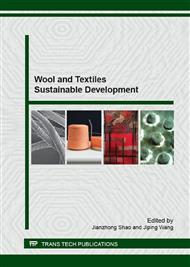[1]
H.W. Zhu, Application of fabric air dispersion system in engineering project, Refrigeration air conditioning & electric power machinery. 30 (2009) 12-14.
Google Scholar
[2]
X.Q. Xing, Numerical simulation air supply characteristics of fabric air dispersion systemin penetration mode, Zhejiang Sci-Tech University. (2014)10-12.
Google Scholar
[3]
P. V. Nielsen, Topp C. & Sonnichsen M, Air distribution in rooms generated by a textile terminal parison with mixing and displacement ventilation, Ashrae Trans. 8 (2005) 733-739.
Google Scholar
[4]
P. V. Nielsen, C.E. Huldgaard, & A. Melikov, Personal exposure between people in a room ventilated by textile terminals with and without personalized ventilation, HVAC & R Research. 13 (2007) 635-643.
DOI: 10.1080/10789669.2007.10390976
Google Scholar
[5]
C. Liu, Comparative study of traditional air supply system and fabric air dispersion system, Huazhong University of science and technology. (2009) 1-7.
Google Scholar
[6]
F. J. Chen, H. X. Chen, J. L. Xie, Effect of fabric air distribution system in penetration air supply mode on indoor comfort, Heating Ventilating & Air Conditioning. 40 (2010) 140-143.
Google Scholar
[7]
F. J. Chen, H. X. Chen & H. Wang, Parametrical analysis on characteristics of airflow generated by fabric air dispersion system in penetration mode, ENERGY AND BUILDINGS. 67 (2013) 365-373.
DOI: 10.1016/j.enbuild.2013.08.020
Google Scholar
[8]
Jackson G W, James D F, The permeability of fibrous porous media, The Canadian Journal of Chemical Engineering. 64 (1986) 3.
Google Scholar
[9]
X.H. Wang, Numerical Simulation of Natural Ventilation and Climate Effect Research on Residencial Building, Tianjin University. (2008) 6-8.
Google Scholar
[10]
X. G. Lin, CFD Simulation of Flow and Temperature Fields in Large Space Building, Nanjing University of Aeronautics & Astronautics. (2007) 19-20.
Google Scholar
[11]
C. He, Research on Airflow and Air Temperature Simulation in the Piggery Based on CFD, Central China Agricultural University. (2009) 26-30.
Google Scholar
[12]
W. B. Su, The Simulationon the Temperature Field and Humidity Field of Subway in Wuhan, Huazhong University of Science and Technology. (2012) 23-31.
Google Scholar


